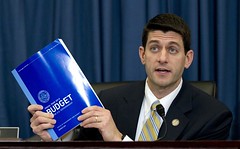Chairman Ryan’s Budget: More of Less
By
Chris Hellman
Posted:
This week the House of Representatives will likely consider the fiscal year 2013 budget resolution, introduced by Congressman Paul Ryan (R-WI), chairman of the House Budget Committee.

Similar to last year’s budget resolution, Chairman Ryan’s proposal looks to cut the overall size of the federal budget and reduce the deficit by a combination of spending cuts and lower taxes intended to stimulate economic growth.
Compared to the Obama Administration's fiscal year 2013 budget request, the Ryan proposal reduces projected federal spending by $5.3 trillion over the next decade. For example, lower projected spending on Medicare would save $205 billion over 10 years compared to the president's budget; it would save $770 billion on Medicaid and other health-related programs; and it would save $352 billion on discretionary programs.
Meanwhile, the Ryan plan would significantly reduce tax revenues by lowering individual and corporate tax rates. Rep. Ryan would compress the current system of six income tax brackets to two – lowering the current top bracket from 35 percent to 25 percent, and keeping the lowest bracket at 10 percent. The proposal also reduces the corporate tax rate from 35 percent to 25 percent.
Taken together, lower spending and smaller revenues don't necessarily mean savings for the government. As Joel Packer, a budget expert at the Raben Group, observed based on one of Chairman Ryan's own charts, the lower revenues resulting from the Ryan proposed tax cuts ($4.39 trillion in lost revenue) more than erase all of the savings his plan generates through spending cuts ($4.149 trillion). So while the Ryan plan calls for much lower spending than current levels, it will actually add $240 billion to the federal debt over 10 years.
Keep following NPP as we go behind the numbers in the fiscal year 2013 budget process.